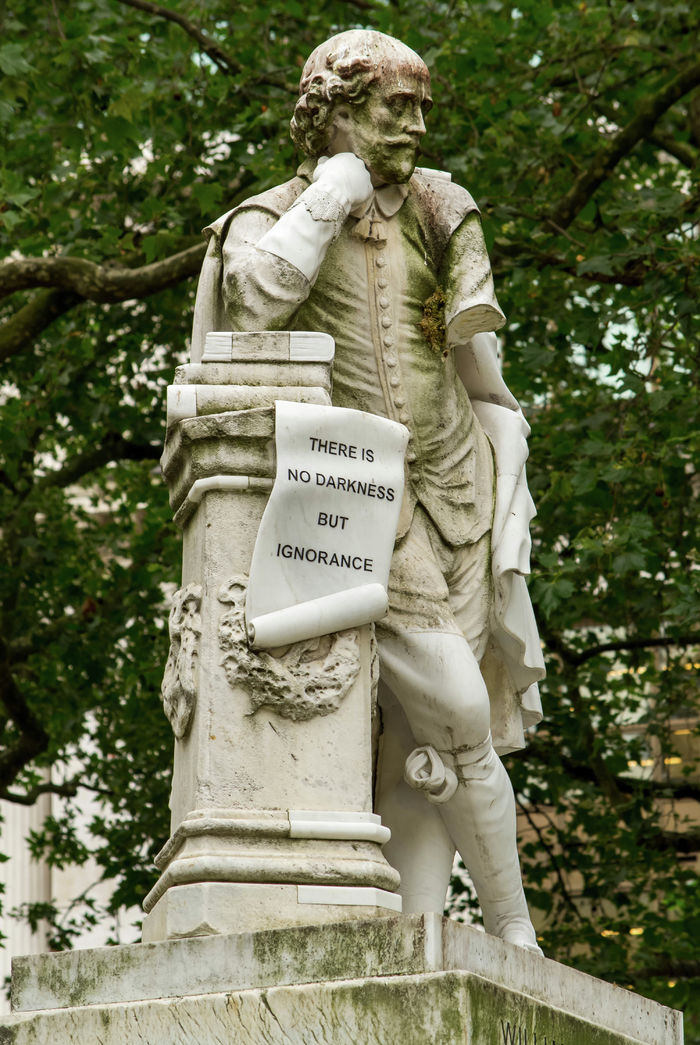King John: “Life (in lockdown) is as tedious as a twice-told tale.”
Columnist Jasmine Regan Feldman reviews the Royal Shakespeare Company’s last performance before their theatre’s closure in March 2020.
The end of Lent Term will mark one year since I saw a play ‘normally’. Without a mask, not online, crammed in with the rest of the crowd.
At the end of Lent, I left college for what I thought would only be a couple of weeks. My mum and sister had come to visit, and we were going to travel to Paris and Geneva for the first time. Those plans were cancelled before they even landed, but instead we decided we would travel the UK. We were still excited. Because I didn’t grow up here, Britain still seems like a fascinating, ‘exotic’ place to me.
Being the theatre and history nerd I am, I’d had my heart set on a trip to Stratford-upon-Avon for quite a while. Unfortunately, with no car and being too broke to afford the train trip, it had never seemed like a feasible possibility. However, my mum paid for the hire car and our plans were set in motion.
“This is not the first time the home of Shakespeare’s plays has had to close due to a pandemic.”
For obvious reasons, don’t go now. But once COVID restrictions improve a bit, I’d highly recommend a trip to Stratford-upon-Avon. That is, as I’ve been sarcastically informed by my English friends, if you haven’t already been dragged there for a school trip. Although it does have something of an odd theme-park feeling to it, Stratford is a beautiful medieval town and only a two-hour drive from Cambridge.
The modern Royal Shakespeare Theatre (RST) in Stratford-upon-Avon opened in 1932 and was designed to echo the same tiered seating style of the original Globe Theatre in London. A trip to Stratford is not complete without a visit, so we went to see if there were any last-minute tickets we could pick up for that night’s performance.
The Life and Death of King John is one of Shakespeare’s less popular and rarely performed biographical plays, so I won’t fault you for not knowing the plot. King John was thought to have been written in the mid-1590s, although it was not published until 1623 as a part of the First Folio. Unsurprisingly, the story follows the tumultuous and somewhat disastrous reign of King John. After his older brother Richard ‘The Lionheart’ died, John was crowned king in 1199, but not without much dispute from the French – who believed the throne belonged to their proposed heir. Thus, England and France were plunged into yet another war. John never lived up to his elder brother’s legacy and was forever remembered as weak, lazy, and a bit too fond of oranges.
The RSC’s production was an outstanding, fresh take on the lesser-known story. Director Eleanor Rhode chose a more modern approach to the play with contemporary twists on the costumes, lighting, and sets. The choice to cast Rosie Sheeny as John was an interesting take on the role; however, she threw herself into it and was utterly convincing as the spoiled, mercurial king.
“The end of Lent Term will mark one year since I saw a play ‘normally’. Without a mask, not online, crammed in with the rest of the crowd. ”
The highlight of the show had to be the live cake fight with the audience. While the characters initially tossed the treats at each other, the buns soon ended up amongst the crowd and were promptly hurled back to raucous laughter from the rest of the audience. After the food fight was over, King John looked up to engage with his advisor but hadn’t noticed he had managed to catch a cream bun on the tip of his crown. The advisor did his best to remain stony-faced while delivering his beautifully poetic 500-year-old verse, however the combined power of John’s piercing stare and his croquembouche crown proved too much for him, and he broke character to burst into laughter as the audience whooped and pointed. John looked up at his crown, pulling the sticky-bun off his head and, perhaps in revenge, lobbed it into the giggling audience.
Stratford-upon-Avon’s RST closed the day after that performance. Yet, this was not the first time the home of Shakespeare’s plays has had to close due to a pandemic. In 1603 and 1608, performances had to be put on hold due to Bubonic Plague outbreaks in London. Both times, the Globe Theatre was able to reopen again eventually. The Globe didn’t close again until 1613, when it, uh, burned to the ground. For the sake of thespians everywhere, let’s hope better things are in store for 2021.
 Music / The pipes are calling: the life of a Cambridge Organ Scholar25 April 2025
Music / The pipes are calling: the life of a Cambridge Organ Scholar25 April 2025 Arts / Plays and playing truant: Stephen Fry’s Cambridge25 April 2025
Arts / Plays and playing truant: Stephen Fry’s Cambridge25 April 2025 Comment / Cambridge builds up the housing crisis25 April 2025
Comment / Cambridge builds up the housing crisis25 April 2025 Interviews / Dr Ally Louks on going viral for all the wrong reasons25 April 2025
Interviews / Dr Ally Louks on going viral for all the wrong reasons25 April 2025 News / Candidates clash over Chancellorship25 April 2025
News / Candidates clash over Chancellorship25 April 2025







